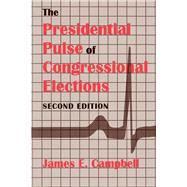
The Presidential Pulse of Congressional Elections
by Campbell, James E.-

This Item Qualifies for Free Shipping!*
*Excludes marketplace orders.
Buy New
Rent Textbook
Rent Digital
Used Textbook
We're Sorry
Sold Out
How Marketplace Works:
- This item is offered by an independent seller and not shipped from our warehouse
- Item details like edition and cover design may differ from our description; see seller's comments before ordering.
- Sellers much confirm and ship within two business days; otherwise, the order will be cancelled and refunded.
- Marketplace purchases cannot be returned to eCampus.com. Contact the seller directly for inquiries; if no response within two days, contact customer service.
- Additional shipping costs apply to Marketplace purchases. Review shipping costs at checkout.
Summary
After reviewing the two major theories of midterm electoral change - the "surge and decline" theory and the theory of midterms as referenda on presidential performance - Campbell draws upon each to propose and test a new theory. He asserts that in the years of presidential elections congressmen ride presidential coattails into office, while in midterm elections such candidates are stranded. An additional factor is the strength of the presidential vote, which influences the number of seats that are won, only to be lost later.
Finally, Cambell examines how the presidential pulse may affect electoral accountability, the relationship between Congress and the president, and the relative strength of Congress, the president, and political parties. He explores the implications of the presidential pulse for understanding electoral change, evaluating the American voter's competence, and assessing the importance of split-ticket voting.
Including both election returns and survey data, this work offers a fresh perspective on congressional elections, voting behavior, Congress, and the presidency.
Author Biography
Table of Contents
| List of Tables and Figures | |
| Acknowledgments | |
| Introduction | p. 1 |
| Theories of Midterm Elections | |
| The Midterm Question | p. 5 |
| The Premises of Surge and Decline | p. 19 |
| The Propositions and Evidence of Surge and Decline | p. 36 |
| The Theory of the Midterm Referendum | p. 63 |
| The Presidential Pulse | |
| The Revised Theory of Surge and Decline | p. 83 |
| Evidence from National Elections | p. 110 |
| Evidence in Congressional Districts | p. 136 |
| Evidence in the Electorate | p. 165 |
| Surge and Decline in Subpresidential Elections | p. 181 |
| Reflections on the Presidential Pulse | p. 197 |
| Epilogue | p. 217 |
| Appendix 1 Presidential Vote and Seat Regressions | p. 222 |
| Appendix 2 Robust Regression of National Evidence | p. 225 |
| Notes | p. 229 |
| References | p. 256 |
| Index | p. 270 |
| Table of Contents provided by Blackwell. All Rights Reserved. |
An electronic version of this book is available through VitalSource.
This book is viewable on PC, Mac, iPhone, iPad, iPod Touch, and most smartphones.
By purchasing, you will be able to view this book online, as well as download it, for the chosen number of days.
Digital License
You are licensing a digital product for a set duration. Durations are set forth in the product description, with "Lifetime" typically meaning five (5) years of online access and permanent download to a supported device. All licenses are non-transferable.
More details can be found here.
A downloadable version of this book is available through the eCampus Reader or compatible Adobe readers.
Applications are available on iOS, Android, PC, Mac, and Windows Mobile platforms.
Please view the compatibility matrix prior to purchase.